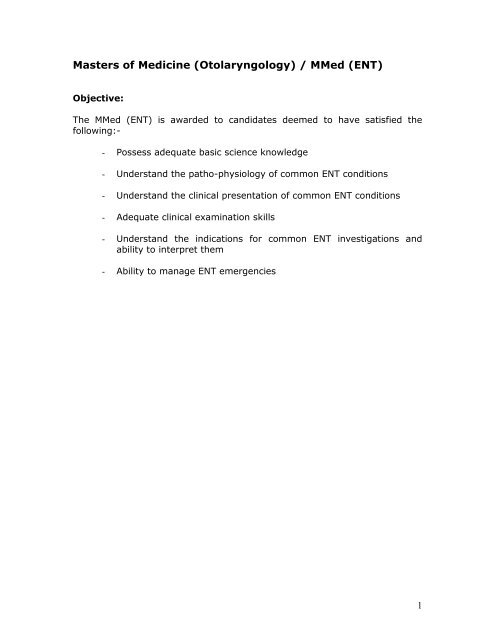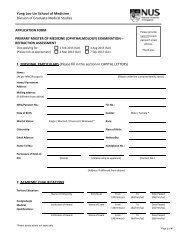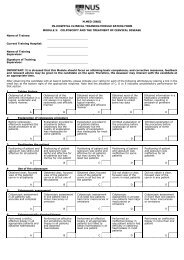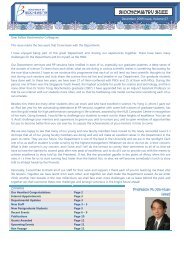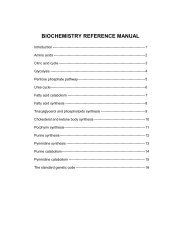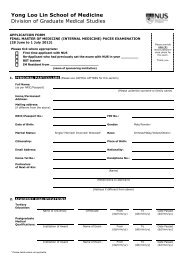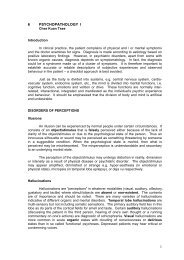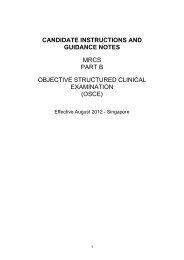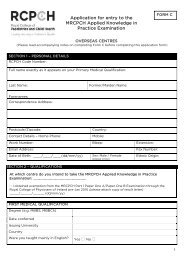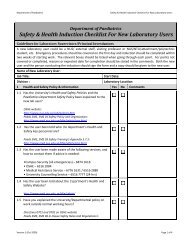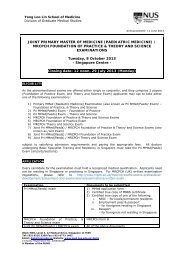Masters of Medicine (Otolaryngology) / MMed (ENT)
Masters of Medicine (Otolaryngology) / MMed (ENT)
Masters of Medicine (Otolaryngology) / MMed (ENT)
- No tags were found...
You also want an ePaper? Increase the reach of your titles
YUMPU automatically turns print PDFs into web optimized ePapers that Google loves.
<strong>Masters</strong> <strong>of</strong> <strong>Medicine</strong> (<strong>Otolaryngology</strong>) / <strong>MMed</strong> (<strong>ENT</strong>)Objective:The <strong>MMed</strong> (<strong>ENT</strong>) is awarded to candidates deemed to have satisfied thefollowing:-- Possess adequate basic science knowledge- Understand the patho-physiology <strong>of</strong> common <strong>ENT</strong> conditions- Understand the clinical presentation <strong>of</strong> common <strong>ENT</strong> conditions- Adequate clinical examination skills- Understand the indications for common <strong>ENT</strong> investigations andability to interpret them- Ability to manage <strong>ENT</strong> emergencies1
SyllabusGeneral <strong>ENT</strong>Management <strong>of</strong> acute surgical diseasesIntensive care: shock management & fluid resuscitationDifferent types <strong>of</strong> anaesthesia and pain controlFundamental <strong>of</strong> surgical techniquesPrinciple <strong>of</strong> wound closureA. Basic ScienceAnatomy <strong>of</strong> the earPhysiology <strong>of</strong> hearing and balanceEmbryology <strong>of</strong> the earAnatomy <strong>of</strong> oral cavity, pharynx, larynx and esophagusAnatomy <strong>of</strong> the neckAnatomy <strong>of</strong> upper airwayPhysiology <strong>of</strong> swallowing, voice productionEmbryology <strong>of</strong> oral cavity, pharynx, larynx and neckAnatomy <strong>of</strong> the nose and paranasal sinuses (including external nose)Physiology <strong>of</strong> the nose and smellDevelopment <strong>of</strong> the nose and paranasal sinuses2
Otology & Neuro-OtologyKEY COMPETENCIESThe candidates will be able to:-• Understand the anatomy and physiology <strong>of</strong> the ear and lateral skullbase• Understand the pathophysiology <strong>of</strong> common ear diseases• Perform pr<strong>of</strong>icient ear and vestibular examination• Assess and manage common ear diseases• Interpret audiological, vestibular and radiological tests for common eardiseases• Pr<strong>of</strong>icient in common ear procedures1. Basic Science1) Describe in detail the anatomy (including embryology) <strong>of</strong> the outer,middle, inner ear, the lateral skull base and facial nerve2) Explain in detail the physiology <strong>of</strong> hearingi) Role <strong>of</strong> pinna and external ear canal in hearingii) Middle ear and its mechanismiii) Cochlear mechanics in hearing, including central control <strong>of</strong> hearing3) Explain in detail the physiology <strong>of</strong> balancei) Semicircular canalii) Utricle and sacculeiii) Central processesiv) Nystagmus4) Interpret common investigations in ear disordersi) Pure tone Audiogramii) Speech audiometryiii) Impedance audiometryiv) Evoked potentials (including ECoG, ABR, AABR, SSEP,CEP)v) Oto-acoustic emissionsvi) Electronystagmographyvii) Vestibulospinal function testsviii) Imaging <strong>of</strong> the ear: CT and MRIix) Facial nerve testing5) Recognise and describe the aetiology, pathology, clinical presentation andtreatment <strong>of</strong> :i) External ear malformationii) Temporal Bone traumaiii) Infective ear conditions:(a) Otitis externa(b) Otitis media3
(c) Cholesteatoma(d) Labyrinthitis(e) Malignant otitis externaiv) Complications <strong>of</strong> infective ear conditionsv) Conductive hearing loss(a) Otosclerosis(b) Tympanosclerosis(c) Ossicular chain disruptionvi) Sensorineural hearing loss(a) Sudden hearing loss(b) Presbycusis(c) Noise induced hearing loss(d) Congenital hearing loss(e) Ototoxicity(f) Fluctuating hearing lossvii) Various causes <strong>of</strong> vertigo(a) BPPV(b) Vestibular neuronitis(c) Meniere’s disease / syndrome(d) Labyrinthitis(e) Central causes(f) Othersviii)Cerebral pontine angle pathology(a) Acoustic neuroma(b) Meningioma(c) Other ptereous apex diseasesix) Facial nerve disorders(a) Bell’s palsy(b) Facial nerve injury(c) Facial nerve tumors2. Clinical Knowledge, Skills and Judgments1) Able to perform otological examination2) Able to manage common otological disorders3) Able to order and interpret tests accurately4) Understand in detail how to perform the following :i) Aural toiletii) Ear foreign body removaliii) Myringotomy and ventilation tube insertioniv) Myringoplastyv) Cortical mastoidectomy4
5) Understand the principles <strong>of</strong>:i) Various mastoidectomies and its controversiesii) Complications <strong>of</strong> common ear surgeries and their managementiii) Ossicular reconstruction and stapes surgeryiv) Various approaches to lateral skull basev) Middle ear and cochlear implants5
AudiologyKEY COMPETENCIESThe candidate will be able to demonstrate:Understanding <strong>of</strong> the physiology <strong>of</strong> the hearing and balanceUnderstand the pathophysiology <strong>of</strong> common hearing loss and balancedisordersUnderstand basic audiological investigations including how it is performedInterpret audiological and vestibular investigationsUnderstand the principle <strong>of</strong> hearing and vestibular testsUnderstand the principles and management <strong>of</strong> patients using hearing aidsUnderstanding the principles and management <strong>of</strong> patients with vestibulardisturbance1. Basic SciencesExplain in detail the audiological science:a. Physics <strong>of</strong> soundb. Measurement <strong>of</strong> soundc. Anatomy <strong>of</strong> the auditory systemd. Physiological and psychological basis for hearinge. Measurement <strong>of</strong> human hearing from birth to adult including:Voice perception testsTuning forks testsAudiometryEvoked potentials (including ECoG, ABR, AABR, SSEP,CEP)Oto-acoustic emissionsImpedance audiometryNeonatal, infant and childhood assessmentExplain in detail the vestibular science:a. the anatomy <strong>of</strong> the vestibular systemb. the physiological basis for balancec. measurement <strong>of</strong> human balance including:Electronystagmography and caloric testing6
Rotational testingTests <strong>of</strong> otolith function2. Practical skillsAudiologicalPerform and interpret:a. Voice perception testingb. Tuning fork testingc. Pure tone audiometry:Air conductionBone conductiond. Masking techniquese. Impedance audiometryf. Speech audiometryVestibularPerform and interpret clinical assessment <strong>of</strong> vestibular function including:a. Eye movementsb. Vestibulo-occular reflexes (static and dynamic)c. Vestibulo-spinal reflexes (static and dynamic)d. Clinical tests for labyrinthine fistula3. Clinical knowledge, skills and judgementAudiological ScienceDefine, diagnose and manage all types <strong>of</strong> diseases related to hearing loss asdetailed in Otology and Neurotology moduleVestibular ScienceDefine, diagnose and manage all types <strong>of</strong> diseases related to dysequilibriumas detailed in Otology and Neurotology module7
4. Rehabilitation SkillsAudiological ScienceReview the process <strong>of</strong> some audiological rehabilitation including:a. Tinnitus management including tinnitus retrainingb. Application <strong>of</strong> hearing aids including:Behind the ear (BTE)In the ear (ITE)In the canal (ITC)Completely in the canal(CIC)c. Bone conduction hearing aidsd. Contralateral routing <strong>of</strong> signale. Bilateral contralateral routing <strong>of</strong> signalf. Assistive listening devicesg. Bone anchored hearing aidsh. Implantable hearing aidsi. Cochlear implantsj. Auditory brainstem implantsk. Tinnitus masking devicesVestibular ScienceDiscuss in detail:a. Particle-repositioning manoeuvres (including Semont, Epley, Brandt-Dar<strong>of</strong>f)b. Graded vestibular exercises (including Cooksey Cawthorne)8
RhinologyKEY COMPETENCIESThe candidate will be able to:• Understand <strong>of</strong> the anatomy and physiology <strong>of</strong> the nose and paranasalsinuses• Understand the pathophysiology, clinical presentation andmanagement <strong>of</strong> common sino-nasal diseases• Interpret diagnostic tests associated with these conditions• Able to counsel and manage patients with these conditions• Communicate realistic outcomes <strong>of</strong> surgery and complications there<strong>of</strong>• Understand the management <strong>of</strong> complications <strong>of</strong> rhinologicalprocedures1. Basic Sciences and Applied Knowledge1) Explain in detail the anatomy <strong>of</strong> the nasal septum, lateral nasal wall andpara-nasal sinuses including innervation, blood supply and embryology.2) Describe the anatomy <strong>of</strong> the frontal recess3) Describe the osteology <strong>of</strong> the maxilla, ethmoid, inferior concha, septum,sphenoid, nasal bones and palatine bones4) Review the physiology <strong>of</strong> the:a) Nasal air flow including tests <strong>of</strong> nasal function – rhinomanometryb) Nasal cyclec) Olfactiond) Nasal mucosa and mucociliary flow5) Recognise and describe the aetiology, pathology and treatment:a) Nasal valve collapseb) Septal perforationc) Nasal septal deviationd) Epistaxise) Allergic rhinitisf) Non-allergic rhinosinusitisi) Infectiveii) Medicamentosaiii) Atrophiciv) Vasomotorg) Fungal sinus disease in all its various formsh) Complications <strong>of</strong> sinusitisi) Nasal polyposis including associated conditions (e.g. Samster's triad)j) Primary ciliary dyskinesiak) Cystic fibrosisl) Specific immunoglobulin (Ig) deficienciesm) Anosmia/hyposmia9
n) Facial pain syndromeso) CSF rhinorrheap) Granulomatous conditionsq) Pyogenic granulomar) Nasal fracturess) Fibrous dysplasiat) HHT --- Osler Rendu Weber Syndromeu) Inverting papillomav) Juvenile angi<strong>of</strong>ibromaw) Sino-nasal malignancyx) Mucocoelesy) Odontogenic disease as related to nose and sinusesz) Systemic diseases6) Understand different diagnostic tests including:a) CT, & MRI imagingb) Histopathologyc) Assessment <strong>of</strong> smelld) Understanding and interpretation <strong>of</strong> RASTe) Understanding the interpretation <strong>of</strong> various clinical tests <strong>of</strong> allergies,including how it is done (inhalant and non-inhalant)f) Measurements <strong>of</strong> nasal airflowg) Tests <strong>of</strong> lacrimal functionh) Tests <strong>of</strong> mucociliary function7) Understand the principles, indications and complications <strong>of</strong>:a) Functional Endoscopic Sinus Surgery (FESS)b) External approach to the sinuses2. Clinical knowledge, skills and judgement1) Evaluate a patient with rhinological problem2) Order and accurately interpret diagnostic tests3) Describe the dangers that can be recognised on a CT/MRI prior to surgery.4) Provide test information to patients in ways that lead to informed decisionmaking5) Demonstrate detailed understanding <strong>of</strong> how to safely perform thefollowing surgical procedures:a) Medical management <strong>of</strong> sinonasal diseaseb) septoplasty / SMRc) turbinate surgeryd) FESSi) Proper handling <strong>of</strong> FESS instruments10
ii) Uncinectomy and MMAe) Antral Washoutf) Various procedures to arrest epistaxisg) Calwell Luc approachh) Frontal trephinei) Nasal foreign body removalj) Nasal fracture reductionk) Nasal haematoma / abscess drainage6) Understand the following procedures:a) Orbital decompression/canthotomy and cantholysisb) External approach to sinuses7) Manage any complications <strong>of</strong> the above procedures, in particular FESS11
Head & NeckKEY COMPETENCIESThe candidate will be able to:• Understand <strong>of</strong> the anatomy and physiology <strong>of</strong> the head & neck region,including deglutition and phonation• Understand <strong>of</strong> the management <strong>of</strong> all common head and neckconditions• Assess a patient with a head and neck malignancy and perform preoperativeassessment, postoperative and rehabilitation management• Collaborate with other pr<strong>of</strong>essionals in the selection and use <strong>of</strong> varioustypes <strong>of</strong> treatments1. Basic Sciences and Applied Knowledge1) Describe in detail the anatomy (including embryology) <strong>of</strong> oral cavity, lips,jaws and tongue, oro-pharynx, naso-pharynx, hypo-pharynx, tracheobronchialtree, larynx, cervical oesophagus, s<strong>of</strong>t tissues <strong>of</strong> the neck,thyroid, para-thyroid gland, salivary glands2) Explain the physiology <strong>of</strong> swallowing, voice production, taste, salivation,upper airway breathing, thyroid and para-thyroid gland3) Discuss nutrition in head and neck disease4) Recognise and describe pathology, clinical presentation and management<strong>of</strong> the head and neck including:a) Tumours --- benign and malignanti) Mucosalii) Skiniii) Salivary glandsiv) Thyroidv) Neurogenicvi) Vascularvii) Other s<strong>of</strong>t tissuesviii) Bone and teethb) Infectionsi) Neck spacesii) Skin and s<strong>of</strong>t tissueiii) Salivary glands including sialolithiasisiv) Thyroidv) Bone and teethvi) Laryngopharynxvii) Oropharynx including tonsils and peritonsillar spacec) Trauma – blunt and penetratingi) Facial fracturesii) Blunt and penetrating neck injuries(1) Visceral12
(2) Vascular(3) Neuraliii) Intubation injuries and their sequelaed) Head and neck manifestations <strong>of</strong> systemic diseasese) Foreign bodies <strong>of</strong> aerodigestive tractf) Gastro-oesophageal/laryngopharyngeal reflux5) Describe, interpret and evaluate diagnostic imaging <strong>of</strong> the head and neckincluding:a) Plain x-raysb) CT scanc) MRId) PETe) Contrast/interventional studiesf) Nuclearg) Ultrasoundh) Video stroboscopy6) Interpretation <strong>of</strong> pathology results:a) Haematologyb) Cytologyc) Anatomical pathology7) Understanding the principles <strong>of</strong> the following as related to head and neck:a) molecular biologyb) immunologyc) geneticsd) epidemiologye) statisticsf) carcinogenesisg) the benefits and deficiencies <strong>of</strong> staging systemsh) laser physics and safetyi) radiation physicsj) antibioticsk) chemo-therapeutic agents2. Clinical knowledge, skills and judgment1) Assess and manage all common benign head and neck conditions2) Evaluate and stage a patient with head and neck cancer3) Discuss the treatment options <strong>of</strong> various head & neck cancers4) Order and accurately interpret diagnostic tests5) Demonstrate detailed understanding in performing the following surgicalprocedures:a) Endoscopici) Oesophagoscopy & foreign body removalii) Bronchoscopy & foreign body removaliii) Laryngoscopy direct +/- biopsyiv) Oesophagoscopy +/- biopsyv) Panendscopy/tumour evaluation +/- biopsyvi) Biopsy <strong>of</strong> solid tumour13
vii) Fine needle aspiration biopsyb) Non endoscopici) Tonsillectomyii) Adenoidectomyiii) Tonsillar/Adenoid haemorrhage controliv) Submandibular Gland excisionv) Neck abscess drainage --- large and smallvi) Tracheostomyvii) Oral laceration repairviii) Nasopharynx biopsyix) Lymph Node biopsyx) Skin graftc) Understand the principles <strong>of</strong> the following procedures:i) Endoscopic(1) Laryngectomy partial resection – Laser(2) Arytenoidectomy resection – Laserii) Open surgery(1) Thyroidectomy(2) Various neck dissections(3) Parotidectomy(4) Laryngectomy: supracricoid, hemi-, vertical and supraglottic(5) Glossectomy and mandibulectomy(6) Defect reconstruction using free flaps, pedicled and local flaps(7) Cranio-facial resection(8) Manage any complications <strong>of</strong> the above procedures(9) Plan, implement and manage pre and post-operative care <strong>of</strong> thehead and neck surgical patient(10) Recognize the role <strong>of</strong> adjuvant therapy in the management <strong>of</strong>head and neck cancer14
Sleep DisorderKEY COMPETENCIESThe candidate will be able to:• Assess patients with snoring and sleep apnoea• Interpret relevant diagnostic tests related to the condition• Consider all relevant options both surgical and non-surgical• Communicate realistic outcomes <strong>of</strong> surgery and their complications• Manage complications1. Basic sciences and Applied KnowledgeDefine:1. Obstructive sleep apnoea2. Apnoea3. Hypopnoea4. Upper Airway Resistance Syndrome5. Respiratory disturbance indexPhysiology <strong>of</strong> sleepExplain the physiology <strong>of</strong>:1. Non- REM (four stages) sleep2. REM sleep3. Relative proportions and changes with agePhysiology <strong>of</strong> airway collapseDescribe the:1. Role <strong>of</strong> nasal airway2. Crani<strong>of</strong>acial skeleton3. S<strong>of</strong>t tissues and musculature4. Fujita classification5. Pathophysiologic consequences including those <strong>of</strong> CPAP6. Blood gas changes (O2, CO2)7. Pulmonary/systemic vasoconstriction15
8. Vagal bradycardia/ectopic cardiac beats9. Sleep arousals10.Cerebral dysfunctionClinical consequences <strong>of</strong> obstructive sleep apnoea1. Recognise and describe the pathology and clinical presentation <strong>of</strong>obstructive sleep apnoea2. Review the consequences <strong>of</strong> obstructive sleep apnoea2. Clinical knowledge, skills and judgement1. Elicit an appropriate clinical history2. Carry out a focused examination3. Dynamic manoeuvres4. Appropriate investigationsInvestigations1. Polysomnogram2. Provide test information to patients in ways that lead to informeddecision makingManagementNon-surgical1. Review the non surgical treatment options for patients suffering fromsnoring and/or sleep apnoea2. Explain the non surgical treatment options to patients in ways that ensurethat they are safely and effective carried out3. Continuous positive airway pressure4. Mandibular advancement splint5. Variable PAP6. Nasal Splinting7. Orthodontic Expansion16
SurgicalAccurately identify indications for surgical interventionRiley and Powell phase 1 &2 surgery (including results)Phase 1Uvulopharyngopalatoplasty/uvulopalato flapPalatal AdvancementHyoid SuspensionGenial tubercle advancementTongue base reduction/advancementPhase 2Maxillary/Mandibular advancementAirway BypassTracheostomyBariatric surgeryEffectively manage any complications <strong>of</strong> the above procedures and theunderlying disease processPlan, implement and manage pre and post-operative care <strong>of</strong> the sleepapnoea patientBe able to describe in detailed, including complications <strong>of</strong> :• UPPP• Tracheostomy17
c. Laryngopharyngeal reflux.d. Role <strong>of</strong> the speech therapist.3. Discuss the principles and techniques <strong>of</strong> operative laryngoscopy.a. Anesthetic considerations in microlaryngeal surgeryb. Microlaryngeal surgery for benign and malignant lesions. Micro-flaptechnique.c. Differences in management <strong>of</strong> nodules, polyps, cysts, respiratorypapillomas, and contact ulcers.d. Principles <strong>of</strong> laser surgery. Safety requirements when operatingwith the laser.e. Management <strong>of</strong> glottic atypia and carcinoma-in-situ.f. Vocal outcomes following trans-oral laser microsurgery forlaryngeal cancer. Malignant laryngeal conditions are covered in thehead and neck section.g. Vocal fold scarring.4. Discuss the causes and treatment principles <strong>of</strong> laryngeal and trachealstenosis.5. Discuss the diagnosis and management <strong>of</strong> neurological conditions such asspasmodic dysphonia, episodic laryngospasm and adductor breathingdystonia. Understand how systemic neurologic conditions such asParkinson’s disease can affect the larynx.6. Discuss the evaluation and management <strong>of</strong> the immobile vocal cord.a. Differential diagnosis and evaluation <strong>of</strong> unilateral vocal cordparalysis.b. Injection laryngoplasty.c. Laryngeal framework surgery.d. Bilateral vocal cord immobility and treatment.7. Discuss techniques <strong>of</strong> voice restoration following laryngeal cancer surgeryincluding electrolarynx, esophageal speech, tracheo-esophageal puncture.8. Discuss the principles <strong>of</strong> management <strong>of</strong> blunt and penetrating trauma tothe larynx, and inhalation and caustic injury.9. Understand the management principles <strong>of</strong> chronic dysphagia andaspiration.a. Postural techniques and swallowing maneuvers such as headrotation and Medelsohn’s maneuver.b. Role <strong>of</strong> surgical management including tracheostomy, vocal foldmedialisation, cricopharyngeal myotomy, epiglottoplasty, laryngealclosure, laryngectomy.c. The role <strong>of</strong> enteral feeding.19


